


December 8, 2018
LUKAS FRANK
–––––––––––––––––––––––––––
Johann Gottfried Müthel: Bach's Last Student

December 8, 2018
LUKAS FRANK
–––––––––––––––––––––––––––
Johann Gottfried Müthel: Bach's Last Student

The 1746 Zacharias Hildebrandt organ at St. Wenceslas in Naumburg, Germany, where Müthel studied with Johann Christoph Altnikol after J.S. Bach's death.
The 1746 Zacharias Hildebrandt organ at St. Wenceslas in Naumburg, Germany, where Müthel studied with Johann Christoph Altnikol after J.S. Bach's death.
The compositions of Johann Gottfried Müthel, the "last pupil of Bach", are rarely performed today. Some rather colorful stories characterize him as withdrawn, moody, and entwined among many odd characters. However, numerous contemporary accounts describe his playing as remarkable, virtuosic, outstanding and brilliant, and throughout his life, his compositions — above all, his works for stringed keyboard instruments — were considered intrinsically profound and highly original.
He is probably less famous today because his compositional output turned out to be relatively sparse. Perhaps this is because (as Müthel said himself) composing made him extremely tired, or on the other hand, because he was afraid to repeat himself too often. As a result, many of his extant pieces (including his organ works) only exist in problematic manuscripts, or as fragments.
The organ works probably served primarily as study material: for keyboard, composition, and improvisation lessons, which at the time were closely interconnected. In this respect, the organ works of Johann Gottfried Müthel are not only excellent in quality and originality — characterized by the (even today) rarely-noticed "Sturm und Drang" style — but they also give us a vivid insight into the comprehensive keyboard pedagogical approach of the time, which probably reflect Müthel's several months' study with Johann Sebastian Bach.
Life
Johann Gottfried Müthel was born on January 17, 1728 in Mölln (northern Germany, about halfway between Hamburg and Schwerin). His parents were Christian Caspar and Anna Dorothea (born Scheve) Müthel. Johann Gottfried was first instructed by his father, who was a City Musician and organist of the St. Nicolai church in Mölln. He later continued his musical education with Johann Paul Kun(t)zen, organist at the Marienkirche in Lübeck.
In 1747, Müthel became a chamber musician and Organist at the court of Duke Christian Ludwig II of Mecklenburg-Schwerin. A one-year study leave financed by the Duke (also with his letter of recommendation) enabled Müthel to study in Leipzig with Johann Sebastian Bach in 1750. At age 22, Müthel also worked with Bach's son-in-law Johann Christoph Altnickol, in addition to Johann Philipp Kirnberger and Johann Christian Kittel. He studied with Bach during his last months in both playing and composition when the already-blind master could no longer leave the house. Bach died about three months after Müthel's arrival. In the weeks following Bach's death, Müthel took over the duties of choral prefect until his replacement.
Müthel continued his studies in the course of the year with Johann Christoph Altnickol in Naumburg, and his travels afterward took him to work with Johann Adolf Hasse and Johann Georg Pisendel in Dresden, to Carl Philipp Emanuel Bach in Potsdam and Berlin, and to Georg Philipp Telemann in Hamburg. After returning to the court in Schwerin, he stayed for about two years in the service of the Duke Christian Ludwig, until he finally took leave on June 4, 1753, moving to Riga, Latvia.
There, Müthel took over the direction of music in the chapel of the Russian dignitary Otto Hermann von Vietinghoff (1722–1792), whose position today could be compared to the Minister of Health. In 1767, he gave up the job as Vietinghoff's Kapellmeister, and took up a position as organist at St. Peter's Church, which had been awarded to him by the City Council a year earlier. In addition, Müthel in Riga is likely to have operated extensively as a freelance musician and teacher in the circle of numerous music lovers.
Müthel died on July 14, 1788 at the age of 60 years in Bienenhof, and was buried two days later in Steinholm (both near Riga). In his will, apart from small foundations, he set his brother Gottlieb Friedrich, a pastor in Seßwegen, as his sole heir.
Source Material and Transmission of the Organ Works
Crediting organ works to Müthel is problematic due to the manuscript sources (there are no prints of his organ works). Two of the three surviving manuscripts with organ music are primarily pedagogical, and are aimed at Müthel's circle of students. Several works are incomplete, or consist of only figured bass; the latter served as improvisation patterns or tasks to be completed by the interpreter or student. On closer inspection, other pieces are actually edits or transcriptions of works by others, but are not explicitly marked as such.
The first two sources are two binders known today as Technische Übungen I ("Technical Exercises I") and Technische Übungen II. In addition to choral preludes and fantasies for organ, they contain pieces and cadenzas for stringed keyboard instruments and transcriptions of works by other composers.
The third source is a manuscript compilation of the works of Georg Poelchau (1773–1836). The volume includes piano concertos (partly in autograph manuscript), harpsichord music, a sonata for flute and basso continuo, a prelude and a fragmentary fugue, as well as an unmarked piece in C major, and three chorale preludes (one of which is by Georg Philipp Telemann).
The fourth source is a supplement to Müthel's copy of the Harmonischen Seelenlust by Georg Friedrich Kauffmann. The print contains a handwritten appendix with a partial copy of J.S. Bach's Orgelbüchlein and other anonymous surviving choral preludes. The chorale prelude Herzlich tut mich verlangen was assigned to Müthel for stylistic reasons. Another prelude to Wohin soll ich fliehen hin (also known as Auf meinen lieben Gott) is incomplete, and the question of Müthel's authorship is still open. Out of the other 17 chorale movements, three could be attributed to Müthel.
The Organ Works
Out of these four sources, a fairly comprehensive picture of the works of Johann Gottfried Müthel that are clearly classified as a solo organ works emerges. Chamber music or vocal works (such as the Cantata: auf die Einweihung der neuen Orgel zu Parchim — "Cantata for the Inauguration of the New Organ at Parchim"), which could be played or accompanied on the organ, are not considered here.
Free Organ Works
Fantasia in G Minor
Fantasia in F Major
Fantasia in E-flat Major (I)
Fantasia in E-flat Major (II)
Fantasia in G Major
Fugue-Fantasia in C Major
Fantasia in C Major
Note: the term "Fantasia" only loosely applies to this repertoire; Müthel himself never uses the word, but editors generally assigned that term to his free works.
Chorale Works
Herzlich tut mich verlangen
Jesu, meine Freude (3 variations)
O Traurigkeit, o Herzeleid
Was mein Gott will, gescheh allzeit
[6 Chorale Movements with Figured Bass]
Christe, der du bist Tag und Licht
Durch Adams Fall ist ganz verderbt
Herr Christ, der einig Gottes Sohn
Jesu, meine Freude
Vater unser im Himmelreich
Von Gott will ich nicht lassen
Incomplete Works
Fantasia in E-flat Major (Fragment)
Fantasia in C Major (Fragment)
Two sketches of a Fantasia in G minor
Praeludium (complete) and Fugue (fragment) in C Major
Wo soll ich fliehen hin/Auf meinen lieben Gott
Given Müthel's focus on the fantasia in his output, and that Müthel's fantasies hardly seem to find their equal in their quality and originality among the generation after J.S. Bach (especially through the extensive use of obligatory pedal), a brief overview of this late eighteenth-century genre is warranted.
In spite of the variability, comparing Müthel's fantasies to contemporary compositions (such as works by the J.S. Bach's sons, Kittel, Kellner, Häßler, and Wolf, for instance) makes it possible to identify several characteristic points that are typical of the "genre" of the "Free Fantasia": namely, the constant change between thematically-based sections in a regular rhythmic meter, and free sections (often without barlines, even exclusively in Müthel's case); additionally, there is a strong sense of virtuosity; sequences, arpeggios and recitatives are also commonly found. Surprising changes of Affekt and colorful inventiveness underline an ideal of the "extemporaneous" musical thought.
Given this context, it makes sense that Müthel's fantasies are mostly only in sketches to be handed down to perhaps his students; they were probably not intended for execution by third parties, because the student should be able improvise a fantasia based on the written model.
Ornamentation
At first glance, it seems natural to transfer the conventions of the Bach tradition to Müthel's music. These are adequately described in sources such as C.P.E. Bach's Versuch über die Wahre Art das Clavier zu spielen. However, on closer examination of Müthel's music (not only the organ works), there are still some questions. Müthel gives some explanatory notes in his Technische Übungen regarding the execution of ornamentation:
Turn
Müthel (as well as other Bach students) often calls for an upward turn, and questions arise about its execution. In Marpurg's Anleitung zum Klavierspielen (Berlin, 1765), this upward turn is described as inverted turn, played as follows:

Pleyel (Klavierschule, Vienna 1801) calls for the execution of the lower secondary note, as does Dussek (Pianoforte-Schule [...], Leipzig, around 1816). Daniel Gottlob Türk, on the other hand, writes in §72 of his Klavierschule, oder Anweisung zum Klavierspielen (Halle, 1789), that "the turn alone is usually indicated by the sign (a) [descending turn] or (b) [upward turn]."

This indicates that there is possibly little distinction between the two signs' actual realization. Türk further states that "the turn (without [any] addition) must always begin with a starting note (above the written note). Marpurg himself also describes elsewhere that the execution of the upper secondary note is the most common. Musically, in most cases, the conventional execution from the upper note seems sensible. Perhaps Müthel leaves the question of execution open (from above/below) and simply indicates a turn, but it is worth noting that Müthel — without exception — only notates upward turns.
Appoggiatura
Müthel himself describes the execution of appogiaturas in his Technische Übungen as follows:


Which is played like this:


Acciaccatura
In his Versuch über die wahre Art das Clavier zu spielen (first edition p. 338, or William J. Mitchell English translation p. 439) C.P.E. Bach describes the acciaccatura as follows: "For all broken three-note [chords] and similar situations, which could be played as a [blocked] three-tone [chord], one can, directly before each interval, play major [b] or minor [c] seconds [see C.P.E. Bach's example below]... This is called 'breaking with acciaccaturas.'"


An example of such an Acciaccatura can be found in Müthel's Fantasia in G Major:
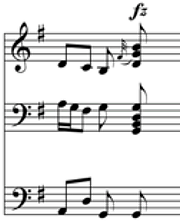
Wedges with Slurs
Müthel gives the following example on the execution of the wedges in combination with slurs in his Technische Übungen:

He says, "[Groups of] four such notes are best performed as follows: the first one is somewhat stronger, the second one, as drawn with a slur to the first; the following two are somewhat thrown away. This is especially [sic.] in singing."
Pedal Technique and Usage
Not without reason was Müthel a celebrated virtuoso, and his technically-demanding music (on the organ seen especially in the intensive use of the pedal) makes it unsurprising that Müthel also occasionally gives pedagogical tips on pedal technique in his Technische Übungen, such as, "when trilling, pick up the feet." Or even more ambiguous utterances such as, "play downward-semitone trills in the pedal with height", or "Many passages [have] trills in the bass" (perhaps the student should practice many passages with trills?). These may be spontaneous notes that address individual technical problems encountered by students in lessons. In addition, he repeatedly makes suggestions on ways to use the pedal, such as "[play] arpeggios in both hands while held tones in the feet" or "hold and bind chords in the hands while working and running passages in the feet."
In his fantasias, Müthel gives us no suggestions about the use of the pedal. In some chorales, he marks the use of pedal with "Ped." In this respect, Müthel stands in the tradition of his Central and Southern German models — in contrast to C.P.E. Bach, for example, whose organ sonatas can be played entirely without pedal (but can be enriched by adding pedals ad libitum).
In many cases, the allocation of the voices to be played in the pedal seems clear — accordingly the Rüdiger Wilhelm edition of the organ works (available here for free) is noted in three lines, the bottom of which is always assigned to the pedal.
It is worth mentioning that, in this context, Müthel's unison passages are not consistently noted the same way in the manuscripts. In places, he writes only the top voice with the note "unis." (e.g. in the first unison passage in the Fantasia in E Flat Major I), but elsewhere he writes the bass with the note "unis." (e.g. in the same fantasia shortly before the end). One can only speculate on whether this leads to interpretational consequences (e.g. that the bass passages are played in the pedals and the passages quoted with the upper part are manual).
In addition, Müthel gives unusual stemmings of some pedal parts; Müthel probably intends notes for the right foot with an upward stem, and notes assigned to the left foot with a downward stem:

It is very interesting to me that in some places the legs are clearly intended to cross. Whether and how Müthel already makes use of this cannot be read from the text. It seems interesting that three other Bach students or grandpupils, including Johann Christian Kittel (Vierstimmige Choräle mit Vorspielen, 1803), Daniel Gottlob Türk (Von den wichtigsten Pflichten des Organisten, 1787) and Johann Samuel Petri (Anleitung zur praktischen Musik für neu angehende Sänger und Instrumentalspieler, 1767/1782 and Anweisung zum regelmäßigen und geschmackvollen Orgelspielen, 1802 — a shortened version of his Anleitung, aimed toward organists) clearly use the toe and heel.
Instruments and Registration
The question of which instruments with pedal best perform Müthel's keyboard works can only be deduced from the structure of the pieces, since no remarks have been made by Müthel or his pupils in this respect.
Several dynamic details in the free works (e.g. the Fantasia in G Minor: f, mf, and p) could suggest that Müthel is thinking of a three-manual organ. This seems to be corroborated by the three-manual instruments he knew during in his time in Naumburg studying with Altnickol, and his position at St. Petri in Riga. However, there is nothing to say that these works could not be performed on a stringed keyboard instrument, such as a pedal clavichord or harpsichord.
There are no concrete registration instructions associated with Müthel's free organ works. A number of theoreticians and composers, such as Johann Mattheson, Friedrich Erhardt Niedt, or Johann Adolf Scheibe are in favor of a plenum registration in organ works without a cantus firmus. However, Jacob Adlung argues about this tendency in his Anleitung zu der musikalischen Gelahrtheit (Erfurt 1758), commenting: "Some people know nothing more about music or a chorale other than the raging of the full work."
Despite that, free works can be performed using the plenum. However, more concrete registration comes from the Berlin composer and publisher Johann Caspar Ferdinand Rellstab in his 1790 edition of the C.P.E. Bach Organ Sonatas (the first edition was published in 1755 ), which I would like to cite here for the sake of completeness:
Sonata in D major:
I. The forte on the main keyboard with the full work and the pedal, a piano [sound] on the upper keyboard with 4' registers: Principal 4', Rorhflöte 4', etc.
II. Gentle registers.
III. Disposition like the first Allegro.
Sonata F major:
The full work, coupled. A piano [sound] in the Nebenwerk ["other division"], but also full.
Sonata in G minor:
I. The full work, but without mixtures. The softer [manual] with flute register in the Nebenwerk.
II. Gentle registers
III. Disposition like the first Allegro.
Sonata in A minor:
Full work. A flute register on the upper keyboard.
Sonata in B flat major:
The forte with the full works, but without 16' in the manual. The piano [keyboard] with a gentle 8' and 4' [stop].
Rellstab's information demonstrates the possibility of registering echoes or piano sections on 4' basis. Whether one assumes that this is intended to be played one octave lower is not clear from the text.
By their context, the interpretation of the chorale-based works suggests an execution on the organ. The only dynamic indication in the choral works is a p in O Traurigkeit, o Herzeleid. It is also possible that the marking "Melodie" also implies a change of sound or manual in the same chorale.
More concrete registration information for chorale works from the Bach tradition come from Kittel, a Bach student, from the first volume of his 1801 textbook Der angehende praktische Organist. For the four-voice choral accompaniment, Kittel requests the "full work." For the chorale preludes, he proposes mostly "soft registrations", with only a few plenum registrations. Regarding tempi, he expressly advocates for slower tempos in his various markings: "Majestätisch, Etwas langsam, Andante, Largo, Ernsthaft, Andante un poco Adagio, Andante ma non troppo, Nicht zu langsam."
Three organs that have shaped Müthel's musical career and certainly influenced his compositional work are still known to us today. The first is the organ of St. Nicolai Church in Mölln by Jacob Scherer, described by Christian Caspar Müthel in 1756 in connection with new additions by the Lübeck organ builder Christian Ludwig Bünting. The registers marked "alt" are those which already existed on the organ; those that Müthel marked "neu" came from Bünting.
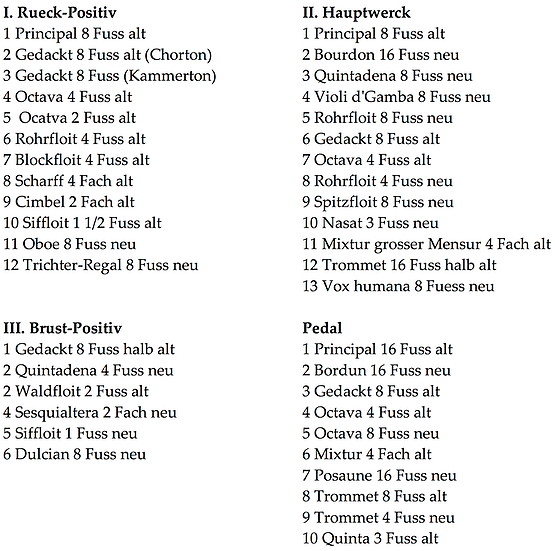
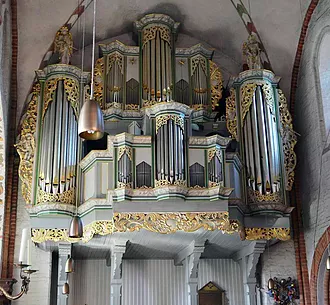


Müthel wanted the organ to be tuned in the "Ordinarien Chor-Thon" ("ordinary choir pitch"), so that "one could play all 24 keys [major and minor] without hurting one's hearing." Furthermore, the key compass should be extended to the "long octave" (but still without c-sharp). The only coupler was the Hauptwerck to Rueck-Positiv.
The conversion took place only in 1766, when Johann Gottfried Müthel was already in Riga. An accurate disposition from the time in which the young Müthel played there does not exist. It is interesting, though, how this change so clearly reflects the new aesthetics of the age: a temperament which would allow all keys to be played (presumably the instrument was previously tuned in some sort of meantone), and also the larger key compass, as well as an expansion of the disposition (including a string on the Hauptwerck), which would introduce a greater tonal variety. Also interesting is the addition of a second Gedackt 8 'in the Rueck-Positiv — one is pitched in line with the rest of the organ in Chorton ("choir pitch"), while the other is in Kammerton (orchestra pitch), which was lower to facilitate playing continuo with other instruments.
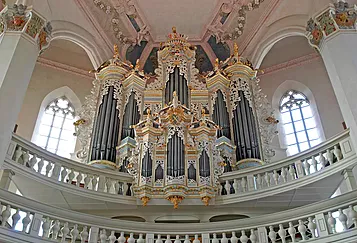
The second is the 1746 Zacharias Hildebrandt organ at St. Wenceslas Church in Naumburg, a typical example of a eighteenth-century Central German organ. Müthel probably got to know the organ well during his study with Altnickol. The case was designed by Zacharias Thayssner, and built between 1659 and 1705.

At St. Petri in Riga, where Müthel spent the longest time of his creative activity, he played a three manual Gottfried Clossen (also Kloss, Klossen, Kloos) organ with 43 registers. The disposition in the original organ contract is as follows:
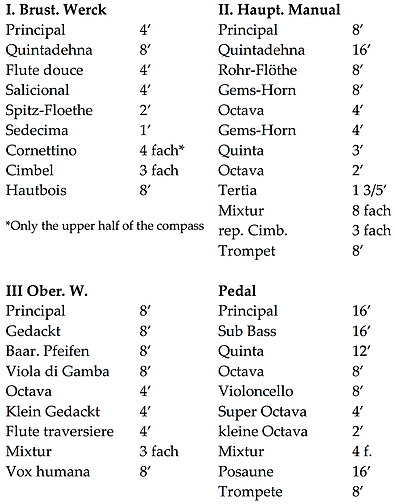

The manuals (C–d3?) and pedal (C–d1?) had a "long octave." A coupler to the main manual was also available (BW-HW?). The organ was tuned to pitch of the "Kammerton," and tuned in the "new temperament."
The Orgelstiftung Petrikirche Riga (founded in 2011) is currently working on a reconstruction of the instrument.
Recordings
The following recordings, which were made as part of my Master's Thesis at the University of Music and Performing Arts Vienna in 2015, are primarily an attempt to present some ways Müthel's organ music can be performed based on this discussion.
When choosing the instrument, I decided in favor of the organ built by Patrick Collon in 2012 in the "New Organ Hall" of the University of Music and Performing Arts Vienna, which is essentially characteristic of a typical eighteenth-century Central German organ in terms of color, key compass and temperament.
In principle, I wanted to approach these pieces according to the aesthetic ideals of an improvised, extemporaneous performance, while at the same time conveying the brilliance and originality so valued by contemporaries of Müthel. Surprising contrasts in Affekt, tempo, and tonality, but also creative handling of the unique material and improvisatory elements seem to me, in short, to be essential stylistic features of this repertoire. In any case, considering the sources, my understanding of the musical aesthetics of the time and the need for some subjective expression, I would like to briefly reflect on and relate my working ideal.
Fantasia in F Major
As far as the registration is concerned, I opted for a slim plenum at the main work in the forte, and guided by Rellstab, I chose a solo Rohrflöte 4' on the Nebenwerk for the piano section.
I have already commented on the basic aesthetics of the fantasia in Müthel's environment. In the specific case of the Fantasia in F Major, I would like to mention a few small things, namely the Fermata at the end of the first part and the "reprise" (on pages 20 and 25 in the new edition of the organ works): Müthel does not write out the repetition of the early part — it is merely shown by the character ⓧ and the note "Them:". The fermate could be interpreted as excluding an improvised cadence for one or both parts, showing only the end of the repetition; alternatively, it might indicate that one should just jump to the conclusion. Furthermore, the "unison" at the end of the fantasia opens the question as to whether the notated voice should also be played in the pedal. Müthel writes only one bass part and adds the other parts only with the written note "unis." The editor suggests playing this line in the pedal, notating it in the third line, but ultimately the player decides how to play it. Even a manualiter execution should not be excluded from consideration.
Johann Gottfried Müthel: Fantasia in F Major, performed by Lukas Frank.
Jesu meine Freude (3 Variations)
Visually, the first variation is a reminder of the free fantasies — notated without barlines — as the chorale melody is woven into the more complex improvisatory passagework. The execution on a manual I think is very conclusive. A realization as a trio is conceivable, but you would have to swap the voices in the middle of the second system on the second page, otherwise the Cantus firmus would move from one manual to another. A fermata on the 6-4 chord in the final cadence indicates a freely improvised cadenza. Such a cadenza can be found in the same page of the source; this is printed in the Wilhelm edition, and I used it in my interpretation.
Johann Gottfried Müthel: Jesu meine Freude, Variation I, performed by Lukas Frank.
Toward the end of the first variation, Müthel already hints at the descending Lombardian motif of the second movement, which also creates an inner connection between the individual verses. This movement, too, is notated without barlines, although it is more rhythmically strict than the first movement.
Johann Gottfried Müthel: Jesu meine Freude, Variation II, performed by Lukas Frank.
In the third verse, Ulrich Matyl (author of Die Choralbearbeitungen der Schüler Johann Sebastian Bachs) notes a striking resemblance to J.S. Bach's setting of the same chorale in his Orgelbüchlein (BWV 610): an unornamented cantus firmus in the soprano, and the bass moving bass in sixteenth notes. The bass motif itself has significant similarities, namely beginning on an upbeat after a rest, the cross motifs, and the successive dropping of the line to the root note. Given the range between the voices and the similarities to the J.S. Bach setting, one could argue that this is a pedaliter work. In most of this variation, Müthel only gives the soprano and bass voices, with figures suggesting that the organist fill in the missing alto and tenor. Only individual elements from the middle voices are noted and suggest a (not quite consistent) four-part, contrapuntal suspension. Based on Müthel's Notitzen, I have worked out my own version. Whether this variation was intended as a composition exercise for students, as a "Pedaletüde", as an impression model or as a composition sketch, one cannot say — perhaps, like so many of Müthel's works, it is a little of everything?
Johann Gottfried Müthel: Jesu meine Freude, Variation III, performed by Lukas Frank.
This article was translated from the original German by Christopher Holman.
––––––––––––––––––––––––
Lukas holds the Hans Balmer Prize for best organ recital at the Schola Cantorum Basiliensis, won second prize at the Primo Concorso Organistico Internazionale "Fondazione della Torre" in Mendrisio, Switzerland, and multiple prizes at the Austrian Jugendmusik-Wettbewerb "Prima la Musica." In 2016, his ensemble L'Armonia Gioiosa was awarded second prize at the Concorso internazionale "Maurizio Pratola" in L'Aquila, Italy. He is now Organist at the Reformed Church in Mellingen, Switzerland, and is Director of the Chamber Choir Rheinfelden-Baden.
The views and opinions expressed in this article are those of the author, and do not necessarily reflect the position of Vox Humana.